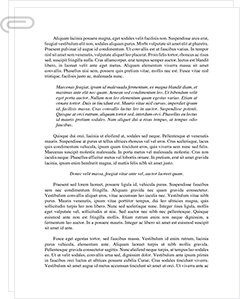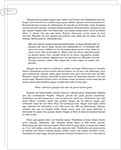 Study Document
Study Document
Deconstruction Architecture Has a Major Research Paper
Pages:2 (903 words)
Sources:4
Subject:Arts
Topic:Modern Architecture
Document Type:Research Paper
Document:#39637053
French architect, Tschumi won the international competition for the planning of the Parc de la Villette that year. A graduate of the Eidgenossische Technische Hochschule, Zurich, his career of dispersion or 'post-humanist' version of deconstruction has furthered the theoretical school of deconstruction architecture through attendant discursive projects outside of building construction.
Since the late twentieth century, Deconstruction's historical landmarks speckle urban metropolises across the globe. For instance, CCTV Building in Beijing, designed by Rem kolhaas, is a merit to the school. In the West, the Guggenheim Museum in Bilbao Spain, designed by Frank Gehry, reveals cultural continuity of institutional deconstruction architecture. Retrospect on deconstructionist architecture has also wrought new priorities in sustainable building. The green construction market has prompted an increase in decentralized supplier relationships with building firms, as local, recyclable sources become more popular.
Theoretical Considerations
A general theory of Modernity in architecture is preface to the Deconstruction in French philosopher, Jacques Derrida's (1967) post-structuralist, semiotic deconstruction of linguistics. The movement's influence within the field of architecture emerged in response to a wider field of scholarly public praxis; directed at destabilizing an entire History of Occidental metaphysics within Western thought. Responsive to Derrida's critique of stasis, the discussion examines the 'event' aspect of deconstruction architecture both through design, and through dissemination as knowledge at the global level. The efficacy of the trace in 'the last instance' asserts a miniature monolith. Without separation from Occidental thought in its entirety the translation of Derrida's semiotic thought into the architectural sphere advanced the proposition of 'organic' design to a point rarely seen in such a break within industrial modes of creative production.
Reinforcement of Deconstruction's project was greatly enhanced by rapid transformations of a new technology sector dedicated to construction materials and engineering systems. Market capitalization of 'creativity' in replication of signature designs (i.e. brand names in architecture) projected a significant future for a field once segregated to function over form. The proliferation of 'green construction' is evidence of a shift in to a 'new market' economy where full cost pricing is equally, if not more, potent in the semiotics of environmental power as design reduced to trace.
Works Cited
Bradley, Guy, 2007. Building Deconstruction. Reed Construction Data 17 October 2007.
Ching, Francis, 2008. Building Construction Illustrated. New York: Wiley & Sons, Inc.
Derrida, Jacques, 1967. Of Grammatology. Baltimore: John Hopkins University Press, 1974.
Gournay, Isabelle, 2010. Tschumi, Bernard. Grove Art Online. Oxford Art Online.
Johnson, Philip, Peter N. And Haslinger, R., 1997. Architecture In Transition: Between Deconstruction and New Modernism. New York: Prestel Verlag.
Karatani, Kojin, ed., 1995. Architecture as Metaphor: Language, Number, Money. Cambridge: MIT Press.
Steinhauer, Jennifer, 2006. Rising Building Costs Send Gehry Project in Downtown Los Angeles Over
Budget. The…
Sample Source(s) Used
Works Cited
Bradley, Guy, 2007. Building Deconstruction. Reed Construction Data 17 October 2007.
Ching, Francis, 2008. Building Construction Illustrated. New York: Wiley & Sons, Inc.
Derrida, Jacques, 1967. Of Grammatology. Baltimore: John Hopkins University Press, 1974.
Gournay, Isabelle, 2010. Tschumi, Bernard. Grove Art Online. Oxford Art Online.
Related Documents
 Study Document
Study Document
Green Architecture in Japan: A Reflection of
Green Architecture in Japan: a Reflection of Societal Values Defining Green Architecture Man has been building structures since shortly after they began to emerge from caves and to explore areas outside his immediate vicinity. Many animals build structures, such as birds and beaver. Many of these structures are functional and serve only to offer protection from predators and the elements, and so it was with the first structures built by man. They
 Study Document
Study Document
Greenwashing in Architecture Its Practice
Greenwashing in ArchitectureIntroductionGreenwashing gives the impression that an organization is engaged in environmentally friendly practices when, in fact, it is causing environmental damage. For example, in 1986, Jay Westerveld claimed that hotels encouraged guests to reuse towels to reduce water use without considering the actual consequences (Pearson, 37-40). Similarly, Ogilvy and Mather argue that greenwashing has increased over the last decade (Hsu). Greenwashing can take seven different forms, according to
 Study Document
Study Document
History of the Modern Era
The history from the Renaissance to the Machine Age was defined by major technical and stylistic advances that allowed for much larger, taller, more elegant buildings, and higher degrees of functionality and architectural expression. In cultural and scientific matters, the Modern Era was characterized by an increasingly rationalistic trajectory of thought which was based on an ethos of the humanistic exploration of reality and truth. While in a cultural sense
 Study Document
Study Document
Antoni Gaudi's Expiatory Temple of the Holy Family
(Antonio Gaudi) it should also be noted that his works draw inspiration from many disciplines and from the input of artists, engineers and sculptors. The first commission that Gaudi was awarded was for the lampposts for the Plaza Real in Barcelona. (Antonio Gaudi) This was followed by various commissions, which included furniture and alter pieces. An early work was the villa El Capricio at the resort area of Comillas. (Antonio
 Study Document
Study Document
Victor Horta: Art Nouveau Movement
According to Schmutlzer, "The buildings of Horta reveal the full importance of architectural initiative" (114). In his book, a History of Modern Architecture, Joedicke (1959) reports that, "In the nineteenth century a circle of adventurous artists, known as 'Les XX,' had already appeared in Brussels, who were strongly influenced by William Morris and his followers. In 1893 Victor Horta, who belonged to this group, built the house in the Rue
 Study Document
Study Document
Suatainable Measures in Construction Plans
A report to sustainable retrofit options for Building 15 Harris Street Ultimo Sydney 622- 632 HARRIS STREET
Introduction
For sustainable future attainment within the construction sector, it is recommended that the sector adopt a multi- disciplinary strategy which takes into account numerous features including energy conservation, more efficient material utilization, emissions and pollution control, and minimization of material wastage. Construction works’ present nature may be improved and controlled by various



